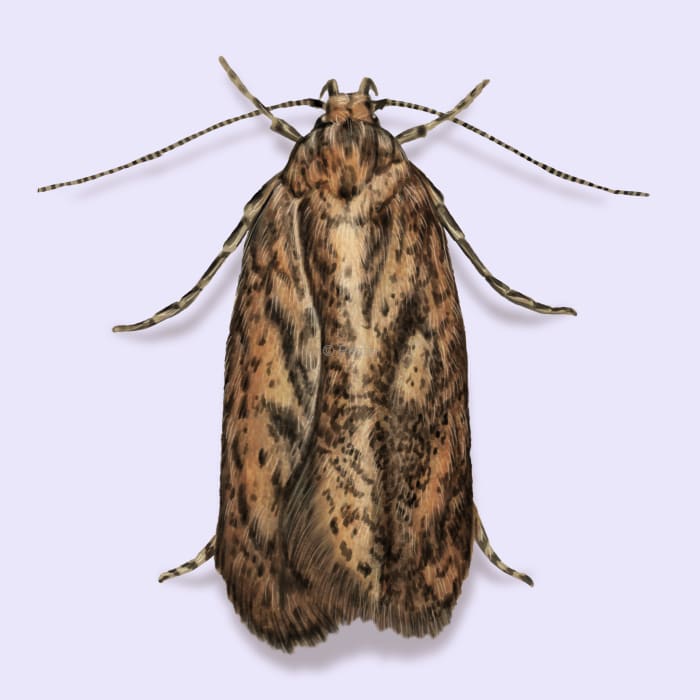How to identify and get rid of brown house moths

Safeguard your wardrobe: combatting brown house moths naturally
Have you ever opened an old book, shaken out a seldom-used blanket, or peeked into your pantry and found a tiny moth fluttering out? If it's a brown house moth, you've just met one of the most common fabric pests in homes.
They have an appetite for a wide variety of items in your home, from cereals and dried fruit in your cabinets to furniture fabric, book bindings, and wine bottle corks.
The caterpillars do all the chewing and eating. They can infest homes and other commercial buildings, making a mess of natural fibers or materials. However, they don’t digest or eat synthetic fibers, so there is some hope to reduce this pest in homes.
Brown house moths rely on human activity for their success and don’t often thrive outside of homes and commercial buildings. They spread through hitchhiking on materials or infested food to make their way into homes or buildings. In nature, they are found in animal nests, more often in bird’s nests.
How to identify brown house moths
Brown house moths are small, light brown moths often speckled with darker brown spots, a pattern that helps them blend into their surroundings. You might recognize them by their narrow wings, which they hold flat over their bodies like a tent when resting. If you’re finding holes in natural fiber clothing, carpets or spotting larvae—which look like small, creamy caterpillars—around these items, it could be a sign that you have a brown house moth infestation.
How big are brown house moths?
Adults have a wingspan of about ½ - 1 inch.
What other pest looks like a brown house moth?
Small brown moths that get into your home can all look alike. However, clothes moths look very similar and do the same type of damage to your fabrics. However, brown house moths are typically larger and darker than the more uniformly pale clothes moths. Either way, the treatment for both moths is similar. It’s not necessary to distinguish between the two.
Where do brown house moths live?
Brown house moths are found throughout the United States, thriving particularly in homes with available food sources and nesting spots.
They are commonly found in dark, undisturbed areas like closets, pantries, and attics, where they can feed on stored fabrics, dried foods, and paper products.
How to get rid of brown house moths
Brown house moths can be a pain to deal with. They can ruin expensive fabrics, furniture, or clothing if left unchecked. Luckily, there are a few ways to treat and prevent brown house moths:
- Proper storage: Store clothes and dry foods in tightly sealed containers to prevent access.
- Cleanliness: Regular vacuuming and cleaning of storage areas help remove potential food sources and larvae.
- Temperature control: Freezing infested items for a couple of weeks or heating them in a hot dryer can kill larvae and eggs.
- Traps: Pheromone traps can attract and capture adult males, reducing the breeding population.
Unfortunately, brown house moths, their eggs and larvae can linger for a long time in a home. It’s important to stay diligent when storing natural fibers and materials.
Treat brown house moths with Pestie
If you're still having trouble keeping brown house moths away, the best option is to use a pro-grade, effective pest control solution like Pestie.
Pestie is a do-it-yourself pest control solution that's specially designed to keep brown house moths and other pests away from your home.
With Pestie, you can rest easy knowing that your living space is protected and free of creepy crawlies. And the best part? It's designed for people, pets, and the planet, so you can say goodbye to harsh chemicals and hello to peace of mind!
- Save hundreds compared to traditional annual pest plans
- People, pet, and planet-friendly
- Pro-grade customized formulas
Quick facts
How dangerous are Brown House Moths?
Medium danger risk
Brown house moths don’t pose any health risks to humans or pets, but they can damage clothing, furniture, or stored food.
- Scientific name
Hofmannophila Pseudospretella
- Colors
Light brown with darker brown speckles
- Life span
11 months indoors
- Diet
Wool, fur, silk, felt, feathers, and stored foods like grains and nuts
They have lactic acid bacteria in their gut that helps them digest keratin. This is one of the reasons why they have become such a destructive pest.








